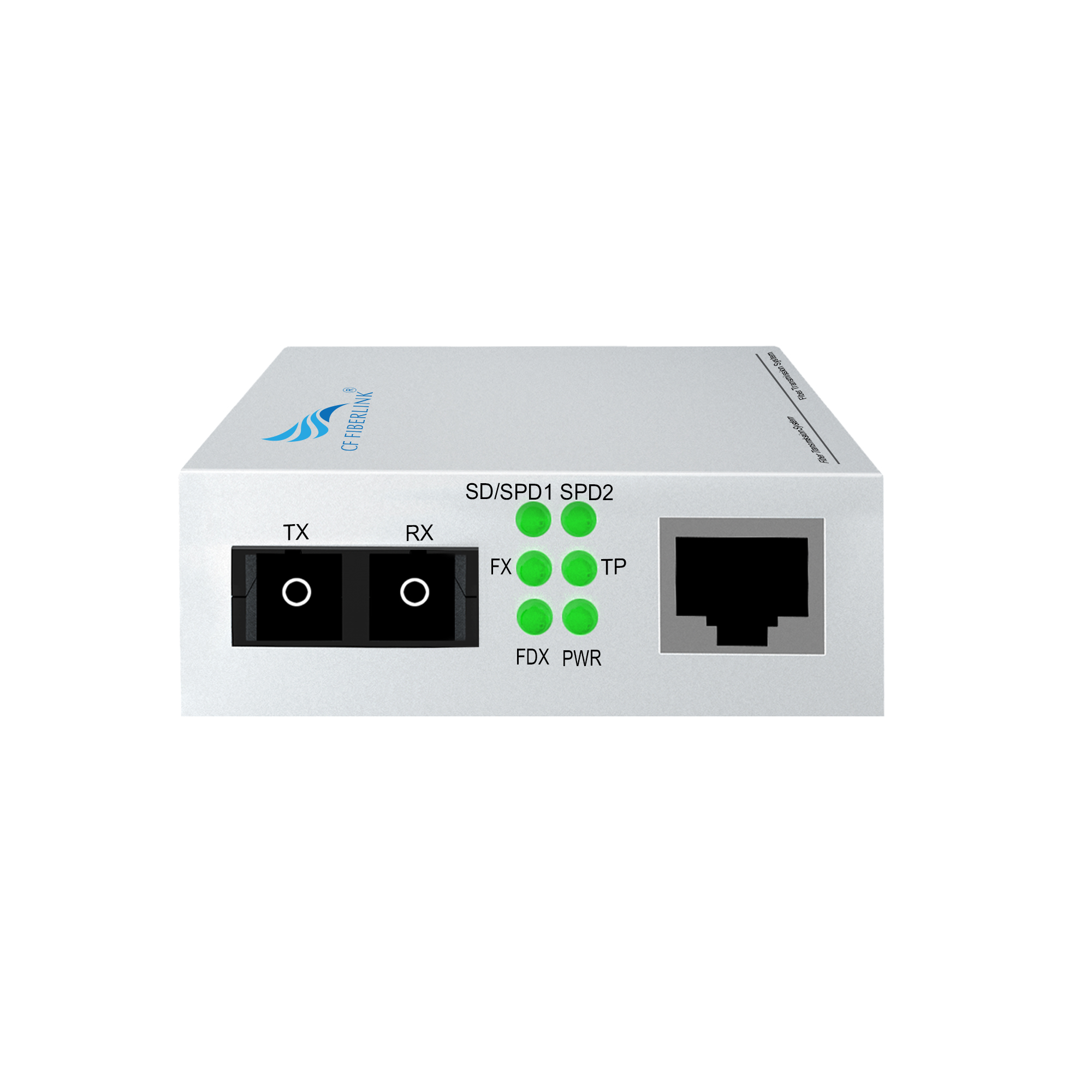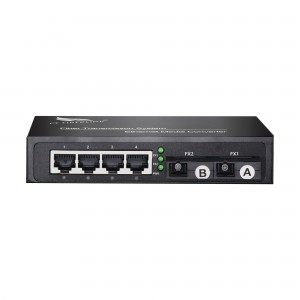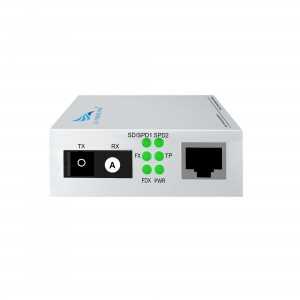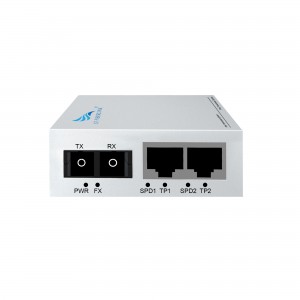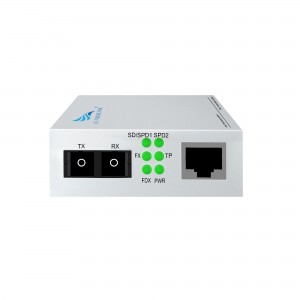2-port 10/100/1000M Media Converter (Single-mode Dual-fiber SC)
2-port 10/100/1000M Media Converter (Single-mode Dual-fiber SC)
Product Features:
Introducing the LED Gigabit 1 Optical 1 Electrical Single Mode Dual Fiber Fiber Optic Media Converter – the ultimate solution for seamless data transmission over optical and electrical networks.
As an unmanaged fiber converter, this cutting-edge product is designed to meet the highest industry standards and provide reliable, efficient transitions between singlemode and dual fiber networks. Developed by Huizhou Changfei Optoelectronics Technology Co., Ltd., an innovative high-tech enterprise known for its excellent wireless bridges and optical modules, this converter is the epitome of excellence in this field.
One of the outstanding features of this fiber optic media converter is its low power consumption. Thanks to its efficient design, it optimizes energy use, thereby reducing operating costs without compromising performance. This environmentally friendly aspect not only helps businesses lower their electricity bills, but also helps preserve our environment.
LED Gigabit 1 Optical 1 Electrical Single Mode Dual Fiber Media Converter is equipped with a 4-digit dial and provides a user-friendly interface for easy configuration and management. This intuitive control panel allows users to easily adjust and fine-tune settings according to their specific requirements, creating a hassle-free experience.
Additionally, to ensure ease of installation and compatibility with industry standard connectors, the converter is equipped with an SC interface. These widely used connectors support high-speed data transmission with low insertion loss for a smooth and reliable connection.
To simplify troubleshooting and improve ease of use, LED indicators on this fiber optic media converter provide real-time status updates. These dynamic LED lights provide instant visual feedback, allowing users to quickly diagnose any potential problems and ensure maximum uptime.
In addition to these impressive features, the LED Gigabit 1 Light 1 Electric Single Mode Dual Fiber Optic Media Converter boasts a strong build quality that ensures longevity and durability. Crafted with great attention to detail, this converter is built to withstand harsh environments and is suitable for a variety of applications.
Whether you are building a new network or expanding an existing infrastructure, this fiber optic media converter is the perfect solution to seamlessly bridge the gap between fiber optic and electrical networks. With its great performance, user-friendly interface, and solid build quality, it’s a reliable and cost-effective choice for businesses of all sizes.
All in all, Huizhou Changfei Optoelectronics Technology Co., Ltd.’s LED Gigabit 1 Light 1 Electric Single Mode Dual Fiber Optical Media Converter is a game changer in the field of data transmission. With its low power consumption, 4-digit dial, SC interface and dynamic LED indicators, it offers an unrivaled combination of performance and usability. Choose this converter and experience data transfer easier than ever.
What This Product Does
◇ The CF-LED102GSW-20 is a media converter designed to convert 1000BASE-X fiber to 1000Base-T copper media or vice versa. Designed under IEEE802.3ab 1000Base-T and IEEE802.3z1000Base-X standards, the CF-LED102GSW-20 is designed for use with single-mode fiber cable utilizing the SC-Type connector. The CF-LED102GSW-20 supports longwave laser specification at a full wire speed forwarding rate. It works at 1310nm on both transmitting and receiving data.
◇ Other features of this module include the ability to be used as a stand alone device (no chassis required), Auto MDI/MDI-X for TX port, and front panel status LEDs. The CF-LED102GSW-20 will transmit at extended fiber optic distances utilizing single-mode fiber up to 20 kilometers.
Other Features
◇ Besides, this media converter can be used as a standalone device (no rack required) or used with CF FIBERLINK’s CF-2U14 rack for auto MDI/MDI-X in TX port in which duplex mode is automatically negotiated.
technical parameter:
|
Model |
CF-LED102GSW-20 | |
| Interface Characteristics | ||
|
Fixed Port |
1* 1000Base-T RJ45 port 1* 1000Base-X uplink SC fiber port |
|
|
Ethernet Port |
1000Base-T auto-sensing, full/half duplex MDI/MDI-X self-adaption |
|
|
Twisted Pair Transmission |
10BASE-T: Cat3,4,5 UTP(≤100 meter) 100BASE-T: Cat5e or later UTP(≤100 meter) 1000BASE-T : Cat5e or later UTP(≤100 meter) |
|
| Optical Port | Default optical module is single-mode dual-fiber 20km, SC port | |
| Wavelength/Distance | single mode: 1310nm 0~40KM ,1550nm 0~120KM | |
| Chip Parameter | ||
| Network Protocol | IEEE802.3 10BASE-T, IEEE802.3i 10Base-T,
IEEE802.3u 100Base-TX, IEEE802.3u 100Base-FX, IEEE802.3x IEEE802.3ab 1000Base-T;IEEE802.3z 1000Base-X; |
|
|
Forwarding Mode |
Store and Forward(Full Wire Speed) |
|
|
Switching Capacity |
4Gbps |
|
|
Buffer Memory |
3Mpps | |
|
MAC |
2K | |
|
LED Indicator |
Fiber | FX(green) |
| rate | SD/SPD1 (green)
SPD2: 100/ 1000 (green) |
|
| Data | TP (green) | |
| Single / duplex | FDX (green) | |
| Power | PWR (green) | |
| Power | ||
| Working Voltage |
AC:100-240V |
|
|
Power Consumption |
Standby<1W, Full load<5W |
|
|
Power Supply |
DC:5V/2A industrial power supply |
|
| Lightning protection &Certification | ||
| Lightning protection | Lightning protection: 4KV 8/20us, Protection level: IP30 | |
| Certification | CCC;CE mark, commercial; CE/LVD EN60950;FCC Part 15 Class B; RoHS | |
| Physical Parameter | ||
| Operation TEMP | -20~+55°C;5%~90% RH Non condensing | |
| Storage TEMP |
-40~+85°C;5%~95% RH Non condensing |
|
| Dimension (L*W*H) | 94mm* 71mm*27mm | |
| Installation | Desktop, CF-2U14 slot rack | |
Product Size:
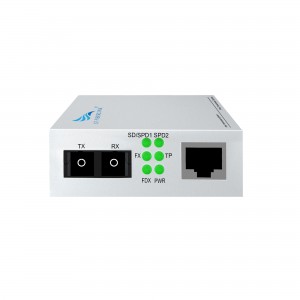
Product application diagra:

How to choose a fiber optic transceiver?
Optical fiber transceivers break the 100-meter limitation of Ethernet cables in data transmission. Relying on high-performance switching chips and large-capacity caches, while truly achieving non-blocking transmission and switching performance, they also provide balanced traffic, isolation and conflict. Error detection and other functions ensure high security and stability during data transmission. Therefore, fiber optic transceiver products will still be an indispensable part of actual network construction for a long time. So, how should we choose fiber optic transceivers?
1. Port function test
Mainly test whether each port can work normally in the duplex state of 10Mbps, 100Mbps and half-duplex state. At the same time, it should be tested whether each port can automatically select the highest transmission speed and automatically match the transmission rate of other devices. This test can be included in other tests.
2. Compatibility test
It mainly tests the connection ability between the optical fiber transceiver and other devices compatible with Ethernet and Fast Ethernet (including network card, HUB, Switch, optical network card, and optical switch). The requirement must be able to support the connection of compatible products.
3. Cable connection characteristics
Test the fiber optic transceiver’s ability to support network cables. First, test the connection ability of Category 5 network cables with lengths of 100m and 10m, and test the connection ability of long Category 5 network cables (120m) of different brands. During the test, the optical port of the transceiver is required to have a connection capability of 10Mbps and a rate of 100Mbps, and the highest must be able to connect to a full-duplex 100Mbps without transmission errors. Category 3 twisted pair cables may not be tested. Subtests can be included in other tests.
4. Transmission characteristics (transmission loss rate of data packets of different lengths, transmission speed)
It mainly tests the packet loss rate when the optical fiber transceiver optical port transmits different data packets, and the connection speed under different connection rates. For the packet loss rate, you can use the test software provided by the network card to test the packet loss rate when the packet size is 64, 512, 1518, 128 (optional) and 1000 (optional) bytes under different connection rates. , the number of packet errors, the number of packets sent and received must be more than 2,000,000. Test transmission speed can use perform3, ping and other software.
5. The compatibility of the whole machine to the transmission network protocol
It mainly tests the compatibility of fiber optic transceivers to network protocols, which can be tested in Novell, Windows and other environments. The following low-level network protocols such as TCP/IP, IPX, NETBIOS, DHCP, etc. must be tested, and the protocols that need to be broadcast must be tested. Optical transceivers are required to support these protocols (VLAN, QOS, COS, etc.).
6. Indicator status test
Test whether the status of the indicator light is consistent with the description of the panel and the user manual, and whether it is consistent with the current status of the fiber optic transceiver.


